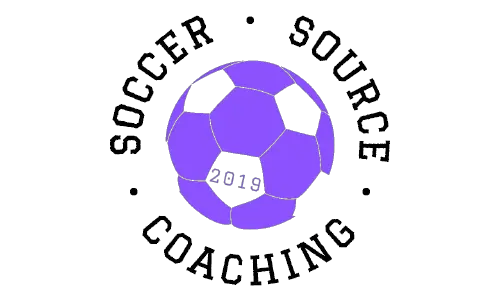In 7v7 soccer, there are a variety of different soccer formations you can set your team up in. In this post, I am going to go over the best 7v7 soccer formation you can use which is the 2-1-3 formation, with videos that will help explain the roles and responsibilities of the players playing those positions and what makes this best formation.
It is important when coaching 7v7 that you have the player’s development at the front of your mind, the 7v7 format allows players to explore different positions, creates more 1v1 opportunities, and gives players more touches on the ball.
The focus on winning must take a back seat.
Why the 7v7 soccer Formation 2-3-1 is the best formation
This 7v7 soccer formation provides a great balance to the team defensively and offensively. This 7v7 soccer formation includes 2 defenders (a left defender and a right defender), 3 midfielders (left midfield, right midfield, and center midfield), and 1 striker.
The way the 7v7 soccer formation is set up (providing all players playing their positions) every time a player receives the ball they will have a minimum of 2 options to pass either forward or backward.
Players can do this because of the large number of triangles that can be created in this formation. See how many you can find with the image below!
As there are 3 different lines of players (defensive line, midfield line, attacking line) this provides depth to the team which naturally creates better passing angles to receive the ball between opposition lines whether it be forward, backward, or sideways.
With a left and right midfield, it encourages the team to get the ball into wide areas and create scoring opportunities from these positions. Overloads can easily be created in attacking scenarios with either wide player being supported either by the striker or the center midfielder.
This formation provides a great foundation to build on as the players get older and move onto larger-sided games.
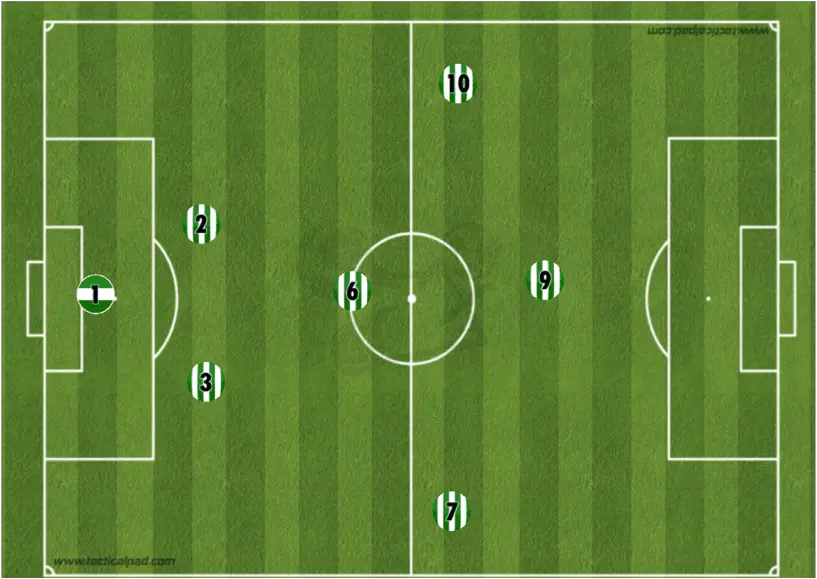
Role of the goalkeeper in this formation
The Goalkeeper is the only player on the team who can use their hands.
They also play an important role in the team as they are the only players that can see the whole pitch, so they must communicate and help keep the rest of the team organized.
The goalkeeper can help the team keep possession and set up attacks with their passing ability as well.
How to help teammates on the ball
As a goalkeeper (red no.1) you want to try and help support your teammates if they cannot go forward. You can then receive a pass from your teammate and play a pass to a teammate who is in space.
Look at the video and see how the keeper can move from side to side depending on which players have the ball to help support them.
When the ball is in the opponent’s half
When our team has the soccer ball in our opponents’ half the goalkeeper can up to the breakout line (halfway in your half).
If the other team clears the ball and it goes past our defenders you will be in a great position to control the ball and pass the ball to a teammate who is in space that can help set up an attack.
Roles of the defenders in this 7v7 formation
In this formation, there are two defenders, a left defender (red 2) and a right defender (red 3). The red-shaded area is space that the left-back should position themselves/ find space in, however, this can change depending on who has the ball and where they are on the pitch.
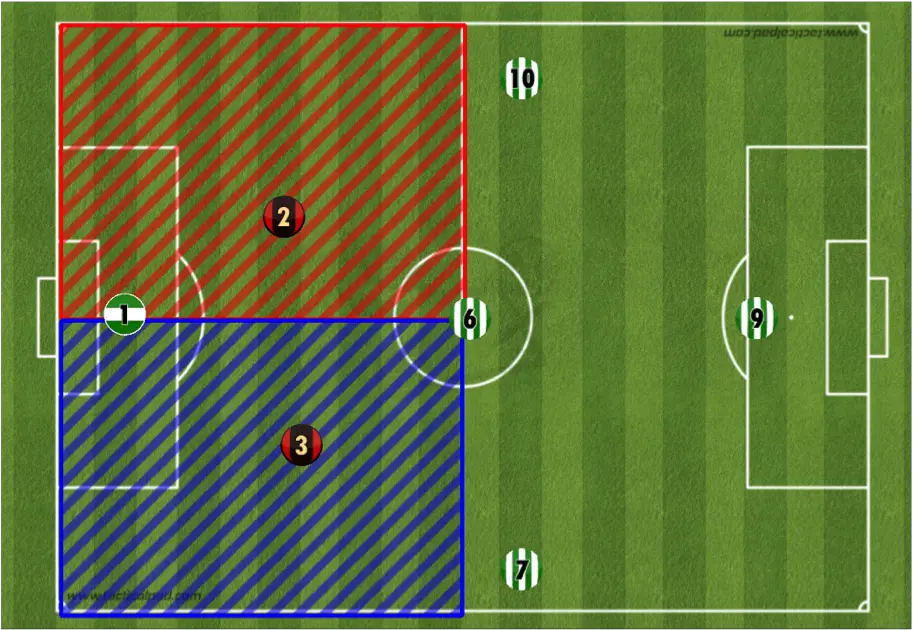
Creating an option for the goalkeeper
The first thing I want the defenders to do is to create an option for the goalkeeper when they have the ball at their feet or take goal kicks. They can create an option by dropping into the wide areas and creating an angle for the goalkeeper as seen in the clip below.
Their body should be facing toward the space, which is where their first touch should take them.
This is a great position to be in on goal kicks. You give yourself more time and space to receive and pass the ball to and from a teammate because you are further away from the breakout line where the other team has to line up.
Even if you don’t receive the ball you will create space for other players to receive the ball.
Supporting your teammates on the ball
Once you have won the ball and passed it to a teammate in space you need to find a space where you can support your teammate on the ball.
This will depend on whether the ball is on the left or the right.
If the left midfielder has the ball on the left the left defender must support the left midfielder if they cannot go forward by moving over to the left-hand side of the pitch and slightly behind so the LM can pass the ball back to them.
The right defender will then come more central so that if the left defender receives the ball they can be an option to help support the left defender.
Similarly, if the ball is on the right-hand side the right defender must move over to the right to support the right midfielder if they cannot go forward.
The left defender will then come across to the middle to support the right defender.
If the ball is in the opponents half and our team has the ball
When the ball is in the opponent’s half whether our team has the ball or the opposing team has the ball, the defenders should be on the halfway line.
If we have the ball you want to help provide an option for our attacking players if they cannot go forward.
If the ball is passed back to you, you are then able to move the ball to players who are in space.
For example, if the has been passed back to you from the left side, the pressure would be coming from the left, so you can try to move the ball to the players who are in space on the right-hand side.
The same can be done if the pressure has come from the right-hand side, you want to try and move the ball to the player who is in space on the left.
If the ball is in the opponent’s half and we do not have the ball
If our team does not have the ball in our opponent’s half we still want to be up at the halfway line.
Similarly to when we have the ball if the opponent has the ball in their half on the left-hand side, the left defender should move over to the left with the right defender coming into the middle and deeper than the left defender so that they are in a great position to cover the left defender.
If the ball is on the right, then the right defender should move over to the right and the left defender coming into the middle and behind the right defender to cover them.
Roles of the centre midfield in this 7v7 formation
In the formation, the center midfielder is the player in the middle of the pitch.
They should be positioned in front of the defenders but slightly behind the LM, RM, and Striker.
In the picture, the green number 6 is the CM and his area to find space in and receive the ball is shaded in blue.
I want my center field to play with their head up so they can see space to attack either by dribbling or passing. They must always support their teammate on the ball by finding space in the middle of the pitch.
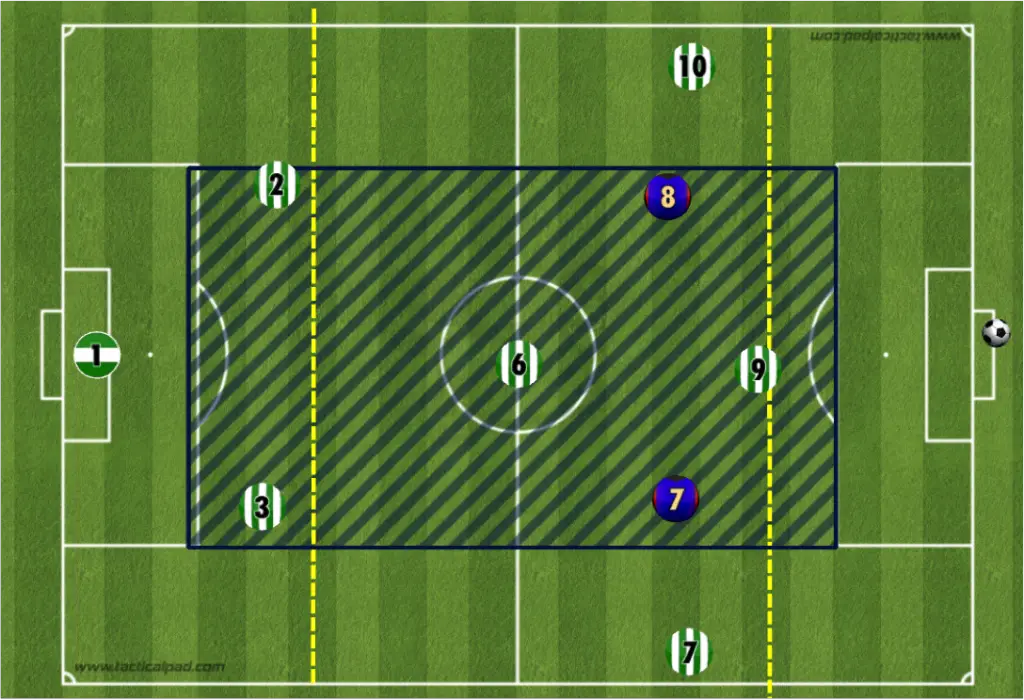
How to help the defenders as a center midfield
When the defenders have the ball the center midfield must give them an option in the middle of the pitch.
When the defenders and LM/RM spread out they draw players to them so this should give you a lot more space in the middle.
(If they are too close to you tell them to get back into their position and find space out wide).
Before you receive the ball from the defender check your shoulder so you know where the space is and where the opposing team is.
This way when you take your first touch you are taking it towards the space and away from the defender.
How to help the attackers as a centre midfield
When we are attacking find a position behind the attackers to help support them if they cannot go forward.
Make sure you are constantly looking around before you receive the ball so you can quickly make a pass to a teammate in space or dribble into space to help create a goal-scoring opportunity.
If the ball is on the left you want to move slightly over to the left and if the ball is on the right move slightly over to the right.
This will make it easier for your teammate to pass to you.
If think you can score from outside the area take a shot too.
Roles of the left and right midfielder in this 7v7 formation
In the 2-1-3 formation, there are play 2 wide players, they play a really important role when we attack as a team.
In the picture, you can see the areas the left and right midfield should be when we are attacking. The left midfield (green 10) area is shaded in red and the right midfield (green 7) area is shaded in blue.
I want to see my left and right midfield finding space in these areas so when they receive the ball they can attack the space in front of them, use skills to try and beat the defenders, and put crosses into the opposing teams’ box for teammates to score or try and take a shot for themselves if they think they can score.
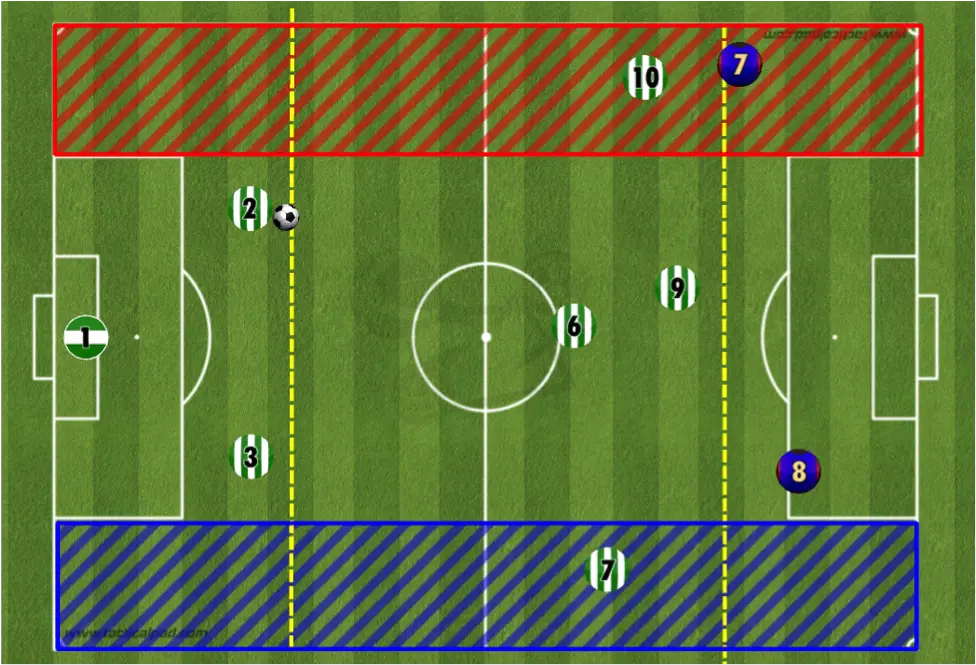
How to help the defenders at left and right midfield
When either our left or right defender gets the ball you must find a space in your wide area to help support them.
Sometimes the defenders will lose the ball and it’s not their fault because the LM or the RM did not find a space to support them.
If the left defender has the ball the left midfielder must find a space out wide so the defender can pass the ball forward to you.
The right midfielder should be doing the same if the right defender receives the ball.
It is your responsibility to make sure the defenders always have you as an option to pass to!
What to try and do when you receive the ball in a wide area as a left and right midfielder
Be confident and positive!
As soon as you receive the ball in a wide area you should be looking to attack the space and beat the defender in front of you.
You must keep your head up as well while you dribble so that you can see teammates in space to cross the ball to or continue going towards the goal to have an attempt.
If you are in a really wide position it can be hard to take a shot because of the angle. Instead of taking the shot can you pass the ball to someone who is in a better position to score.
What to do if you are the left midfield or right midfield and you cannot shoot or pass to someone who can score
Remember if you cannot pass the ball forward or take a shot remember you can pass backward by looking after the ball passing to teammates behind us our team can help start an attack by finding players in a different space.
See in this video how you can work the ball as a team across to the other wide player by looking after the ball and passing back to your teammates.
The role of the striker in this 7v7 formation
As mentioned earlier the striker is the furthest player forward, so you must stay up because as soon as we win the ball back we want to try and get it to our striker as quickly as possible.
In the picture, I have highlighted the area where the striker should be trying to find space. They are the green no. 9
I want the striker to be confident in taking shots with both feet and dribbling past players.
When they are shooting they should be aiming for the corners of the goal as this is very hard for the goalkeeper to reach
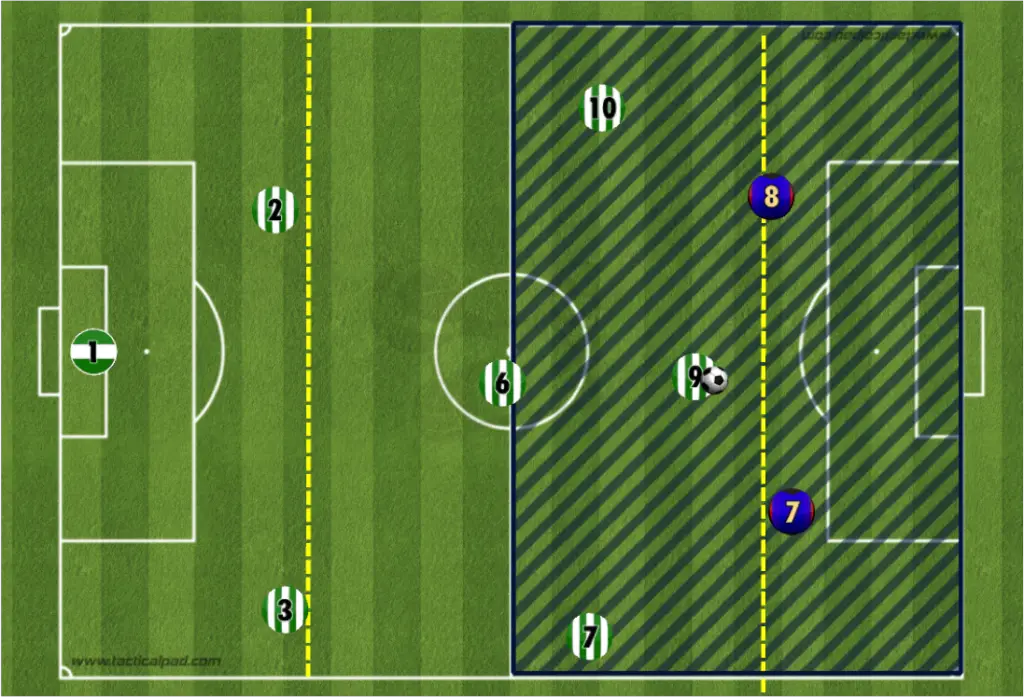
When the ball is in our own half
If the ball is in our half the striker should stay in the opposing team’s half trying to find space to receive the ball so you can receive the ball from a teammate.
Depending if the ball is on the left or right you can move to that side of the area to help support that player to give them an option forward either receiving the ball to your feet or making a run behind the defenders.
When the ball is in the opponent’s half
When the ball is in our opponent’s half can you try and find space and positions where if you receive the ball you can have a shot on goal.
Sometimes you may find a great space to receive the ball but the pass or cross may not come, don’t be annoyed, try to find another space to score.
A great place to move and find space is behind or between the defenders where they can’t see you or where they have to keep turning around to see you.
This makes it very hard to mark you and easier for your teammates to play passes to you.
7v7 soccer formation conclusion
Thank you for taking the time to read and watch through my post on the best 7v7 soccer formation to use and the roles of the players in the formation, if you found this helpful or know someone who would, please share below using our social media buttons.
Let me know what you think as well in the comments, is this the best 7v7 soccer formation or do you use a different formation?
Thank you,
Toby
Related Links:
- 20 Soccer Drills for u10
- 15 Drills for Passing and Moving
- 8 Dribbling Drills for u8
- Youth Soccer Positions Made Easy
My Soccer Coaching Equipment
If you opened my coaching bag this is the soccer equipment you’d find!
